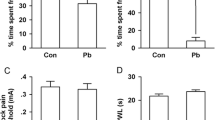Summary
The long-term consequences of neonatal exposure to triethyl lead, the putative neurotoxic metabolite of the anti-knock gasoline additive tetraethyl lead, were examined with respect to central nervous system (CNS) development. We presently report a series of studies in which exposure of neonatal rats to organic lead produces profound CNS damage in adulthood as indicated by dose-dependent, persistent behavioral hyperreactivity as well as dose-dependent, preferential, and permanent damage to the hippocampus. General morphological parameters of brain development were not altered. Pharmacological probes of neurotransmitter system integrity suggested a functional and dose-dependent relationship between this behavioral hyperreactivity and hippocampal damage via cholinergic, but not dopaminergic, pathways. Furthermore, these alterations were not accompanied by long-term alterations in motor activity and were not attributable to the presence of lead in adult neural tissue. Finally, these behavioral, anatomical, and pharmacological indices of developmental exposure to organic lead were dissociable from any effects of early undernutrition. These data collectively indicate that organolead compounds may pose a potent neurotoxic threat to the developing CNS.
Similar content being viewed by others
References
Kehoe, R. A., J.A.M.A.85 (1925) 108.
U.S. Environmental Protection Agency, Air Quality Criteria for Lead, Environmental Criteria and Assessment Office, Research Triangle Park, North Carolina, 1986.
U.S. Department of Energy, Energy Information Administration, Mon. Energy Rev. Jan. (1989) 35–54.
U.S. Department of Interior, Bureau of Mines, Mineral Yearbook-19871 (1989) 541.
Craig, P. J., and Rapsomanikis, S., Environ. Sci. Technol.19 (1985) 726.
Schmidt, U., and Huber, F., Nature259 (1976) 157.
Stevens C. D., Feldhake, C. J., and Kehoe, R. A., J. Pharmac. exp. Ther.128 (1960) 90.
Hayakawa, K., Jap. J. Hyg.26 (1971) 526.
Nielsen, T., Jensen, K. A., and Grandjean, P., Nature274 (1978) 602.
Jensen, A. A., in: Biological Effects of Organolead Compounds, pp. 97–115. Ed. P. Grandjean. CRC Press, Boca Raton, Florida 1984.
Grandjean, P., in: Biological Effects of Organolead Compounds, pp. 227–241. Ed. P. Grandjean. CRC Press, Boca Raton, Florida 1984.
Hunter, A. G. W., Thompson, D., and Evans, J. A., Teratology20 (1979) 75.
McClain, R. M., and Becker, B. A., Toxic. appl. Pharmac.21 (1972) 265.
Keenlyside, R. A., in: Biological Effects of Organolead Compounds. pp. 219–225. Ed. P. Grandjean. CRC Press, Boca Raton, Florida 1984.
Valpey, R., Sumi, S. M., Copass, M. K., and Goble, G. J., Neurology28 (1978) 507.
Robinson, R. O., J.A.M.A.240 (1978) 1373.
Cremer, J. E., Br. J. ind. Med.16 (1959) 191.
Cremer, J. E., and Calloway, S., Br. J. ind. Med.18 (1961) 277.
Booze, R. M., and Mactutus, C. F., Teratology33 (1986) 99c.
Mactutus, C. F., and Booze, R. M., Teratology31 (1985) 11B.
Winer, B. J., Statistical Principles in Experimental Design. McGraw-Hill, New York 1971.
Mactutus, C. F., and Fechter, L. D., science223 (1984) 409.
Gray, J. A., and McNaughton, N., Neurosci. Biobehav. Rev.7 (1983) 119.
Glowinski, J., and Iverson, L. L., J. Neurochem.13 (1966) 655.
Swanson, L. W., in: Neurobiology of the Hippocampus, pp. 3–19. Ed. W. Seifert. Academic Press, London 1983.
Springer, J. E., and Isaacson, R. L., Brain Res.252 (1982) 185.
Butcher, L. L., and Woolf, N. J., in: Handbook of Chemical Neuroanatomy, vol. 3, Classical Transmitters and Transmitter Receptors in the CNS, Part II, pp. 1–50. Eds A. Bjorklund, T. Hokfelt and M. J. Kuhar. Elsevier, Amsterdam 1984.
De Jonghe, W. R. A., and Adams, F. C., Atmos. Environ.14 (1980) 1177.
Nielsen, T., Egsgaard, H., Larsen, E., and Schroll, G., Analyt. Chim. Acta124 (1981) 1.
Campbell, J. B., Wooley, D. E., Vijayan, V. K., and Overmann, S. R., Devl. Brain Res.3 (1982) 595.
Alfano, D. P., LeBoutillier, J. C., and Petit, T. L., Exp. Neurol.75 (1982) 308).
Author information
Authors and Affiliations
Rights and permissions
About this article
Cite this article
Booze, R.M., Mactutus, C.F. Developmental exposure to organic lead causes permanent hippocampal damage in Fischer-344 rats. Experientia 46, 292–297 (1990). https://doi.org/10.1007/BF01951770
Received:
Accepted:
Published:
Issue Date:
DOI: https://doi.org/10.1007/BF01951770



